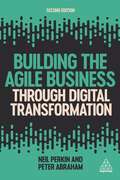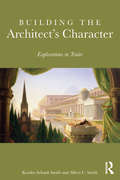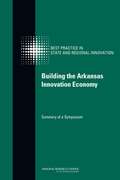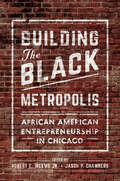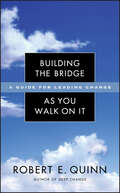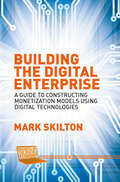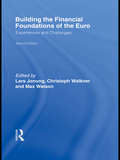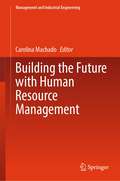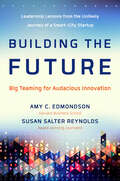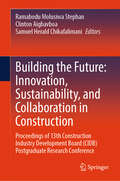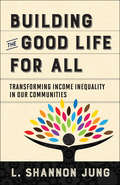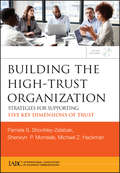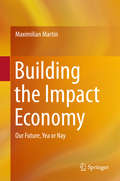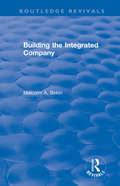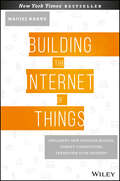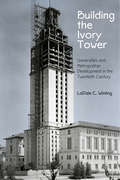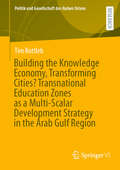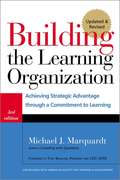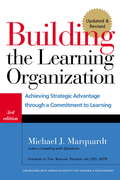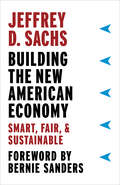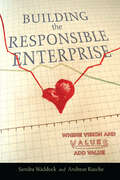- Table View
- List View
Building the Agile Business through Digital Transformation
by Neil Perkin Peter AbrahamHow can businesses transform to achieve competitive advantage in a digital-enabled world? How can managers and leaders create a culture that supports lasting change through these transformations?Building the Agile Business through Digital Transformation is an in-depth guide for all those needing to better understand, implement and lead digital transformation in the workplace. It sets aside traditional thinking and outdated strategies to explain what steps need to be taken for an organization to become truly agile, embed innovation and develop talent to succeed.This majorly revised second edition of Building the Agile Business through Digital Transformation contains new material on the culture and mindset challenges of shifting at scale from linear to agile working, and using data effectively in organizational decision-making. Full of practical advice, examples and real-life insights from organizations at the leading edge of digital transformation including AirBnb, Amazon and Google, this book is an essential guide to driving success by becoming an agile and digital native business.
Building the Architect's Character: Explorations in Traits
by Albert C. Smith Kendra Schank SmithAn understanding of architects’ character traits can offer important insights into how they design buildings. These traits include leadership skills necessary to coordinate a team, honest and ethical behavior, being well educated and possessing a life-long love of learning, flexibility, resourcefulness, and visionary and strategic thinking. Characteristics such as these describe a successful person. Architects also possess these traits, but they have additional skills specifically valuable for the profession. These will include the ability to question the use of digital media, new materials, processes, and methods to convey meaning in architectural form. Although not exhaustive, a discussion of such subjects as defining, imaging, persuading, and fabricating will reveal representational meaning useful for the development of an understanding of architects’ character. Through the analogies and metaphors found in Greek myth, the book describes the elusive, hard-to-define characteristics of architects to engage the dilemmas of a changing architectural landscape. Building the Architect’s Character: Explorations in Traits examines traditional and archetypal characteristics of the successful architect to ask if they remain relevant today.
Building the Arkansas Innovation Economy: Summary of a Symposium
by Charles W. WessnerA committee under the auspices of the Board on Science, Technology, and Economic Policy (STEP), is conducting a study of selected state and regional programs in order to identify best practices with regard to their goals, structures, instruments, modes of operation, synergies across private and public programs, funding mechanisms and levels, and evaluation efforts. The committee is reviewing selected state and regional efforts to capitalize on federal and state investments in areas of critical national needs. Building the Arkansas Innovation Economy: Summary of a Symposium includes both efforts to strengthen existing industries as well as specific new technology focus areas such as nanotechnology, stem cells, and energy in order to better understand program goals, challenges, and accomplishments. As a part of this review, the committee is convening a series of public workshops and symposia involving responsible local, state, and federal officials and other stakeholders. These meetings and symposia will enable an exchange of views, information, experience, and analysis to identify best practice in the range of programs and incentives adopted. Drawing from discussions at these symposia, fact-finding meetings, and commissioned analyses of existing state and regional programs and technology focus areas, the committee will subsequently produce a final report with findings and recommendations focused on lessons, issues, and opportunities for complementary U. S. policies created by these state and regional initiatives. Since 1991, the National Research Council, under the auspices of the Board on Science, Technology, and Economic Policy, has undertaken a program of activities to improve policymakers' understandings of the interconnections of science, technology, and economic policy and their importance for the American economy and its international competitive position. The Board's activities have corresponded with increased policy recognition of the importance of knowledge and technology to economic growth. One important element of STEP's analysis concerns the growth and impact of foreign technology programs. 1 U. S. competitors have launched substantial programs to support new technologies, small firm development, and consortia among large and small firms to strengthen national and regional positions in strategic sectors. Some governments overseas have chosen to provide public support to innovation to overcome the market imperfections apparent in their national innovation systems. They believe that the rising costs and risks associated with new potentially high-payoff technologies, and the growing global dispersal of technical expertise, underscore the need for national R&D programs to support new and existing high-technology firms within their borders.
Building the Black Metropolis: African American Entrepreneurship in Chicago
by Jason Chambers Robert Weems Jr.From Jean Baptiste Point DuSable to Oprah Winfrey, black entrepreneurship has helped define Chicago. Robert E. Weems Jr. and Jason P. Chambers curate a collection of essays that place the city as the center of the black business world in the United States. Ranging from titans like Anthony Overton and Jesse Binga to McDonald's operators to black organized crime, the scholars shed light on the long overlooked history of African American work and entrepreneurship since the Great Migration. Together they examine how factors like the influx of southern migrants and the city's unique segregation patterns made Chicago a prolific incubator of productive business development ”and made building a black metropolis as much a necessity as an opportunity. Contributors: Jason P. Chambers, Marcia Chatelain, Will Cooley, Robert Howard, Christopher Robert Reed, Myiti Sengstacke Rice, Clovis E. Semmes, Juliet E. K. Walker, and Robert E. Weems Jr.
Building the Bridge As You Walk On It: A Guide for Leading Change (Jossey-bass Leadership Ser. #204)
by Robert E. QuinnBuilding the Bridge As You Walk On It tells the personal stories of people who have embraced deep change and inspired author Robert Quinn to take his concept one step further and develop a new model of leadershipthe fundamental state of leadership. The exploration of this transformative state is at the very heart of the book. Quinn shows how anyone can enter the fundamental state of leadership by engaging in the eight practices that center on the theme of ever-increasing integrityreflective action, authentic engagement, appreciative inquiry, grounded vision, adaptive confidence, detached interdependence, responsible freedom, and tough love. After each chapter, Quinn challenges you to assess yourself with respect to each practice and to formulate a strategy for personal growth.
Building the Digital Enterprise: A Guide to Constructing Monetization Models Using Digital Technologies (Business in the Digital Economy)
by Mark SkiltonThe digital economy is at a tipping point. This practical book defines digital ecosystems, discusses digital design using converging technologies of social networking, mobility, big data and cloud computing, and provides a methods for linking digital technologies together to meet the challenges of building a digital enterprise in the new economy.
Building the Digital Manufacturing Enterprise of the Future at Siemens
by Willy ShihThis case describes the motivation for and the development of Siemens' digital manufacturing enterprise vision, which became the foundation for its implementation of Industrie 4.0. While the effort started with a purely defensive move by Anton Huber, head of the Digital Factory Division, to protect his core programmable logic controller business from the migration of value to software from hardware, the scope expanded radically as the company completed the acquisition of UGS. It was then able to articulate a complete roadmap from computer-aided product inception and design through simulation and automation system design all the way to the factory floor. The initial implementation at the Electronics Works Amberg became widely cited as the prototype for Industrie 4.0. The central question of the case is the importance of vertical integration to the delivery of the vision, in the face of pressure for open standards that will expose large parts of the system to competition and price pressure. How will Siemens earn a reasonable rate of return?
Building the Ecosystem: A Lesson from the Biosphere-Your Business's Green Growth Can Cause Creative Destruction in Your Industry
by Gregory C. UnruhThe process of release and restructuring-of creative destruction-is what keeps the biosphere productive and allows it to fill even the most extreme environments. As you steer your business toward green growth, you may be undertaking innovations that can foster similar destruction in your industry. You don't have to wait for conditions to change, however, because business doesn't respond only to the external environment. This chapter outlines how your company can encourage its own supportive ecosystem-like using the biosphere's niche strategy to establish a foothold where there wasn't one for your green products and services. To help you foster creative destruction in your industry, this chapter outlines different approaches to influencing and integrating your efforts with peers, suppliers, customers, and even competitors-building the necessary supportive ecosystems so that you end up on the right side of creative destruction. This chapter was originally published as the Conclusion of "Earth, Inc.: Using Nature's Rules to Build Sustainable Profits."
Building the Financial Foundations of the Euro
by Lars JonungFirst Published in 2008. Routledge is an imprint of Taylor & Francis, an informa company.
Building the Future with Human Resource Management (Management and Industrial Engineering)
by Carolina MachadoThis book explores the dynamic landscape of contemporary organizations, navigating through topics such as innovation, creativity, emotional intelligence, technology, and sustainability. The book shows how high-skilled workers synergize with machines, emphasizing the evolving nature of work into a talent-centric domain. It delves into human resource management, offering a comprehensive understanding of its strategic significance in fostering innovative, creative, and socially responsible organizations. The chapters guide the reader through an array of topics, from technological trends in HRM to the ethical dimensions of responsible management and the strategic approach to fostering gender equality. Each chapter, authored by experts in management and engineering, serves as a beacon of knowledge, providing executives, managers, engineers, academics, and students with the essential tools and insights needed to propel organizations into the future.
Building the Future: Big Teaming for Audacious Innovation
by Susan Salter Reynolds Amy EdmondsonBuilding the FutureMachiavelli famously wrote, "There is nothing more difficult to take in hand, more perilous to conduct, or more uncertain in its success than to take the lead in the introduction of a new order of things."That's what this book is about—innovation far more audacious than a new way to find a restaurant or a smart phone you can wear on your wrist. Amy C. Edmondson and Susan Salter Reynolds explore large-scale systemic innovation that calls for "big teaming": intense collaboration between professions and industries with completely different mindsets. This demands leadership combining an expansive vision with deliberative incremental action—not an easy balance. To explore the kind of leadership required to build the future we need, Edmondson and Reynolds tell the story of Living PlanIT. This award-winning "smart city" start-up was launched with a breathtakingly ambitious goal: creating a showcase high-tech city from scratch to pilot its software—quite literally setting out to build the future. This meant a joint effort spanning a truly disparate group of software entrepreneurs, real estate developers, city government officials, architects, construction companies, and technology corporations. By taking a close look at the work, norms, and values in each of these professional domains, we gain new insight into why teaming across fields is so challenging. And we get to know Living PlanIT's leaders, following them and their partners through cycles of hope, exhaustion, disillusionment, pragmatism, and renewal. There are powerful lessons here for anyone, in any industry, seeking to drive audacious innovation.
Building the Future: Proceedings of 13th Construction Industry Development Board (CIDB) Postgraduate Research Conference
by Clinton Aigbavboa Ramabodu Molusiwa Stephan Samuel Herald ChikafalimaniThis conference proceedings present cutting-edge research that is shaping the future of the construction industry. It has a strong emphasis on sustainability, digital transformation, and emerging technologies. It contains contributions from experts in academia, industry, and policy who engage in critical discussions on how artificial intelligence, digitalisation, and innovation can drive efficiency, enhance project outcomes, and modernise the sector. The proceedings address key challenges, including skills shortages, infrastructure limitations, and adoption barriers, to help foster industry-wide transformation. The cidb conference attracted researchers, industry professionals, policymakers, and stakeholders from across the construction sector, and its proceedings offer valuable insights into emerging trends and best practices. The conference proceedings are designed for those seeking to explore the intersection of technology, sustainability, and construction management in an evolving global landscape.
Building the Good Life for All: Transforming Income Inequality In Our Communities
by L. Shannon JungThe well-being of those who are financially secure depends on the well-being of those who are not, those who fall into the working poor, or Asset-Limited, Income-Constrained, Employed (ALICE). We are interdependent both materially and spiritually and are diminished by the extent to which we do not flourish together. <P><P>In Building the Good Life for All, L. Shannon Jung explores four strategies for mutual flourishing: charity, self-help, cultural value formation, and government action. Rather than theorizing on the causes of people's poverty, the chapters demonstrate how these transformational strategies work and how others can participate in them. Discussion questions with each chapter help groups process what they are learning and how they can apply these strategies personally and in their community. <P><P>Designed to be read and discussed in seven sessions, this book encourages the social ministry of churches and the community development of neighborhoods. Churches and community groups will find themselves revitalized through this study and through enacting its strategies to help their neighbors.
Building the Governance to Take Capital SAFI to the Next Level
by V. G. Narayanan F. Asis Martinez-Jerez Mariana CalAsset management firm Capital SAFI wanted to attract new strategic investors and expand to other countries. Having the right corporate governance in place was critical to achieve this goal.
Building the High-Trust Organization
by Pamela S Shockley-Zalabak Michael Hackman Sherwyn MorrealeBased on IABC sponsored research in over 60 organizations, this guide provides an easy-to-administer model and instrument for measuring and managing trust in organizations. An explanation and practical applications accompany each of the model's five critical dimensions of trust: Competence, Openness and Honesty, Concern for Others, Reliability, and Identification. Using rich case examples and interviews, the book examines diverse approaches and opportunities for building trust--in peer groups, virtual environments, and with managers/supervisors, and top management. Individual interviews represent diverse organizational positions, responsibilities, perspectives, and geographic locations.Note: CD-ROM/DVD and other supplementary materials are not included as part of Kindle edition of this book.
Building the Impact Economy: Our Future, Yea or Nay
by Maximilian MartinThis book develops a comprehensive framework for creating sustainable new business approaches on a massive scale. It relates the power of entrepreneurship, investment and technology to four areas in which progress is urgently needed to get out of the world's current impasse. These are: game-changing innovations in companies; a way forward for the global fashion industry that reconciles competitiveness and worker dignity; turning around the energy crisis; and restoring capital markets to being the funders of human progress and prosperity that they once were--the pieces of the puzzle that is our future. Numerous case studies and actionable guidelines show how to concretely get the job done.
Building the Integrated Company
by Malcolm A. BirkinThis title was first published in 2000: Global competition is increasingly impacting on even the most isolated of companies; the only way for any company to sustain competitive advantage is by tapping into the single remaining area of great potential - the management of people. If we want to be an above-average company, we will need an above-average ratio of above-average people who perform at above-average levels. None of which will happen without above-average levels of management. Malcolm Birkin’s Building the Integrated Company offers a model for exploiting the human potential within organizations. This potential is one which, in previous decades, through an absence of focus on business basics and an adherence to mistaken ideas about sustainable competitive advantage, we have contrived to turn into all-too-limited performance. The first stage in any new learning process is to unlearn the misplaced concepts and bad habits we have developed. Section One of the book describes and contrasts the similarities and differences of American, European and Japanese management and then describes the characteristics of the Integrated Company, which has absorbed and perfected the best systems and philosophies from around the world. Anyone seeking to follow this lead needs to be able to distinguish the realities of these management systems from the myths. Section Two is built around a series of 13 detailed and scored questionnaires, containing over 240 individual questions, enabling the reader to assess every aspect of their business, from management focus to the behaviours of the workforce, against the Integrated Company model. Section Three, the largest and most important section, deals with integration, addressing the practical implementation of the systems and philosophies in a clear, logical and hands-on manner. As the name suggests, the Integrated Company is a holistic model, involving every aspect of the business. Nevertheless, managing people - the unlimited potential - remains the most complex
Building the Internet of Things: Implement New Business Models, Disrupt Competitors, Transform Your Industry
by Maciej KranzConnect your organization to the Internet of Things with solid strategy and a proven implementation plan Building Internet of Things provides front-line business decision makers with a practical handbook for capitalizing on this latest transformation. Focusing on the business implications of Internet of Things (IoT), this book describes the sheer impact, spread, and opportunities arising every day, and how business leaders can implement IoT today to realize tangible business advantages. The discussion delves into IoT from a business, strategy and organizational standpoint, and includes use-cases that illustrate the ripple effect that this latest disruption brings; you'll learn how to fashion a viable IoT plan that works with your organization's strategy and direction, and how to implement that strategy successfully by integrating IoT into your organization tomorrow. For business managers, the biggest question surrounding the Internet of Things is what to do with it. This book examines the way IoT is being used today—and will be used in the future—to help you craft a robust plan for your organization. Grasp the depth and breadth of the Internet of Things Create a secure IoT recipe that aligns with your company's strategy Capitalize on advances while avoiding disruption from others Leverage the technical, organizational, and social impact of IoT In the past five years, the Internet of Things has become the new frontier of technology that has everyone talking. It seems that almost every week a major vendor announces a new IoT strategy or division; is your company missing the boat? Learn where IoT fits into your organization, and how to turn disruption into profit with the expert guidance in Building the Internet of Things.
Building the Ivory Tower: Universities and Metropolitan Development in the Twentieth Century (Politics and Culture in Modern America)
by LaDale C. WinlingToday, universities serve as the economic engines and cultural centers of many U.S. cities, but how did this come to be? In Building the Ivory Tower, LaDale Winling traces the history of universities' relationship to the American city, illuminating how they embraced their role as urban developers throughout the twentieth century and what this legacy means for contemporary higher education and urban policy.In the twentieth century, the federal government funded growth and redevelopment at American universities—through PWA construction subsidies during the Great Depression, urban renewal funds at mid-century, and loans for student housing in the 1960s. This federal aid was complemented by financial support for enrollment and research, including the GI Bill at the end of World War II and the National Defense Education Act, created to educate scientists and engineers after the launch of the Soviet satellite Sputnik. Federal support allowed universities to implement new visions for campus space and urban life. However, this growth often put these institutions in tension with surrounding communities, intensifying social and economic inequality, and advancing knowledge at the expense of neighbors.Winling uses a series of case studies from the Progressive Era to the present day and covers institutions across the country, from state schools to the Ivy League. He explores how university builders and administrators worked in concert with a variety of interests—including the business community, philanthropists, and all levels of government—to achieve their development goals. Even as concerned citizens and grassroots organizers attempted to influence this process, university builders tapped into the full range of policy and economic tools to push forward their vision. Block by block, road by road, building by building, they constructed carefully managed urban institutions whose economic and political power endures to this day.
Building the Knowledge Economy, Transforming Cities? Transnational Education Zones as a Multi-Scalar Development Strategy in the Arab Gulf Region (Politik und Gesellschaft des Nahen Ostens)
by Tim RottlebThis book explores the strategies of governments in Doha, Dubai and Ras al-Khaimah in the Arab Gulf to attract offshore campuses of foreign universities. These campuses, predominantly Western, are drawn by policies creating transnational education zones (TEZs) that offer infrastructures, legal exceptions and administrative benefits, while evoking vibrant international academic communities. Governments expect TEZs to develop local higher education and drive economic transformation towards knowledge-based economies. Adopting a cultural political economy perspective, the book integrates insights from urban and economic geography with debates on the Gulf’s political economy and transnational higher education. Through qualitative interviews and document analysis, it reveals how governments leverage the zones and their offshore campuses to generate contingent skilled labour and position their cities as international education hubs. This work highlights how governments, driven by the economic imaginary of the knowledge-based economy, create exceptional spaces to navigate the global-local dynamics of transnational higher education.
Building the Learning Organization: Achieving Strategic Advantage Through A Commitment To Learning
by Michael J. MarquardtThis essential best-practices toolkit with lessons from world-class leaders-FedEx, Nokia, Alcoa, Whirlpool, Microsoft, and others-tells how to successfully transform an organization into one that not only continually learns from its experiences but quickly translates that knowledge into improved performance. Rich with hands-on tools and dozens of new examples and case studies, this highly anticipated updated edition of the award-winning Building the Learning Organization puts the power of the author's Systems Learning Organization model into the hands of any manager who wants to participate in building, maintaining, and sustaining the next generation of learning organizations.
Building the Learning Organization: Mastering the Five Elements for Corporate Learning
by Michael J. MarquardtThis essential best-practices toolkit with lessons from world-class leaders—FedEx, Nokia, Alcoa, Whirlpool, Microsoft, and others—tells how to successfully transform an organization into one that not only continually learns from its experiences but quickly translates that knowledge into improved performance. Rich with hands-on tools and dozens of new examples and case studies, this highly anticipated updated edition of the award-winning Building the Learning Organization puts the power of the author’s Systems Learning Organization model into the hands of any manager who wants to participate in building, maintaining, and sustaining the next generation of learning organizations.
Building the New American Economy: Smart, Fair, & Sustainable
by Jeffrey D. SachsThe influential economist offers a persuasive strategy for a more just and sustainable economy—with a forward by Bernie Sanders. The New York Times has said that Jeffrey D. Sachs is &“probably the most important economist in the world.&” Now, in a book that combines impassioned manifesto with a plan of action, Sachs charts a path to move America toward sustainable development. Sustainable development is a holistic approach to public policy that unifies economic, social, and environmental objectives. By focusing too much on short-term economic growth, the United States has neglected rising inequality and dire environmental threats—all while putting our long-term economic growth at risk. Sachs explores issues that have captivated national discourse, including infrastructure, trade deals, energy policy, the proper size and role of government, the national debt, and income inequality. In accessible language, he illuminates the forces at work in each case and presents specific policy solutions. His argument rises above the stagnation of partisanship to envision a brighter way forward both individually and collectively. &“Sachs demonstrates expertise on vastly different policy fields and makes a convincing case that abdicating the toxic intersection of militarism and exceptionalism is key to building a brighter future.&”—Global Policy Journal
Building the New American Economy: Smart, Fair, and Sustainable
by Jeffrey D. SachsIn this passionate and powerful book—part manifesto, part plan of action—the renowned economist Jeffrey D. Sachs offers a practical strategy to move America, seemingly more divided than ever, toward a new consensus: sustainable development. Sustainable development is a holistic approach that emphasizes economic, social, and environmental objectives in shaping policy. In focusing too much on economic growth, the United States has neglected rising economic inequality and dire environmental threats. Now, even growth is imperiled.Sachs explores issues that have captivated the nation and political debate, including infrastructure, trade deals, energy policy, the proper size and role of government, the national debt, and income inequality. Not only does he provide illuminating and accessible explanations of the forces at work in each case, but he also presents specific policy solutions. His argument rises above the pessimism born of political paralysis, economic stagnation, and partisanship to devise a brighter way forward, achievable both individually and collectively. In Building the New American Economy, Sachs shows how the United States can find a path to renewed economic progress that is fair and environmentally sustainable.
Building the Responsible Enterprise: Where Vision and Values Add Value
by Sandra Waddock Andreas RascheBuilding the Responsible Enterprise provides students and practitioners with a practical, yet academically rooted, introduction to the state-of-the-art in sustainability and corporate social responsibility. The book consists of four parts, highlighting different aspects of corporate responsibility. Part I discusses the context in which corporate responsibility occurs. Part II looks at three critical issues: the development of vision at the individual and organizational levels, the integration of values into the responsible enterprise, and the ways that these building blocks create added value for a firm. Part III highlights the actual management practices that enable enterprises to achieve excellence, focusing on the roles that stakeholder relationships play in improving performance. The book concludes with a conversation about responsible management in the global village, examining the emerging infrastructure in which enterprise finds itself today. Throughout the text, cases exemplify key concepts and highlight companies that are guiding us into tomorrow's business environment.
